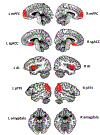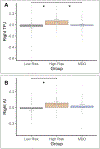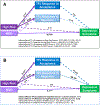Neural activation to peer acceptance and rejection in relation to concurrent and prospective depression risk in adolescent and pre-adolescent girls
- PMID: 37352911
- PMCID: PMC10530136
- DOI: 10.1016/j.biopsycho.2023.108618
Neural activation to peer acceptance and rejection in relation to concurrent and prospective depression risk in adolescent and pre-adolescent girls
Abstract
Neurobiological sensitivity to peer interactions is a proposed marker of risk for adolescent depression. We investigated neural response to peer rejection and acceptance in relation to concurrent and prospective depression risk in adolescent and pre-adolescent girls. Participants were 76 girls (Mage=13, 45% racial/ethnic minorities) varying in depression risk: 22 with current major depressive disorder (MDD), 30 at High Risk for MDD based on parental history, and 24 at Low Risk with no psychiatric history. Girls participated in the Chatroom-Interact task-involving rejection and acceptance feedback from fictitious peers-while undergoing functional magnetic resonance neuroimaging. Activation in response to peer rejection and acceptance was extracted from regions of interest. Depressive symptoms were assessed at 6- and 12-month follow-up. Girls with MDD showed blunted left subgenual anterior cingulate response to acceptance versus girls in High and Low Risk groups. Girls in the High Risk group showed greater right temporo-parietal junction (rTPJ) and right anterior insula (AI) activation to both acceptance and rejection versus girls in the MDD (rTPJ) and Low Risk (rTPJ, AI) groups. Greater rTPJ response to rejection was associated with fewer depressive symptoms at 12-months and mediated the association between High Risk group status and 12-month depressive symptoms; greater rTPJ response to acceptance mediated the association between High Risk and increased 12-month depressive symptoms. Our finding of associations between altered neural response to peer interactions and concurrent and prospective depression risk/resilience highlights the importance of neural underpinnings of social cognition as risk and compensatory adaptations along the pathway to depression.
Keywords: Acceptance; Adolescence; Anterior cingulate cortex; Anterior insula; Brain development; Chatroom Interact; Depression; FMRI; Female; Girls; Major depressive disorder; Peer relationships; Rejection; Sex differences; Social; Temporoparietal junction.
Copyright © 2023 Elsevier B.V. All rights reserved.
Conflict of interest statement
Declaration of Competing Interest The authors declare that they have no known competing financial interests or personal relationships that could have appeared to influence the work reported in this paper.
Figures






Similar articles
-
Increased neural response to peer rejection associated with adolescent depression and pubertal development.Soc Cogn Affect Neurosci. 2014 Nov;9(11):1798-807. doi: 10.1093/scan/nst175. Epub 2013 Nov 21. Soc Cogn Affect Neurosci. 2014. PMID: 24273075 Free PMC article.
-
Hooked on a thought: Associations between rumination and neural responses to social rejection in adolescent girls.Dev Cogn Neurosci. 2023 Dec;64:101320. doi: 10.1016/j.dcn.2023.101320. Epub 2023 Oct 30. Dev Cogn Neurosci. 2023. PMID: 37922608 Free PMC article.
-
Subgenual anterior cingulate responses to peer rejection: a marker of adolescents' risk for depression.Dev Psychopathol. 2011 Feb;23(1):283-92. doi: 10.1017/S0954579410000799. Dev Psychopathol. 2011. PMID: 21262054 Free PMC article.
-
The role of peer rejection in adolescent depression.Depress Anxiety. 2013 Sep;30(9):809-21. doi: 10.1002/da.22120. Epub 2013 Apr 17. Depress Anxiety. 2013. PMID: 23596129 Review.
-
Subgenual anterior cingulate cortex and hippocampal volumes in depressed youth: The role of comorbidity and age.J Affect Disord. 2016 Jan 15;190:726-732. doi: 10.1016/j.jad.2015.10.064. Epub 2015 Nov 12. J Affect Disord. 2016. PMID: 26600415 Review.
Cited by
-
The Role of Neural Sensitivity to Social Evaluation in Understanding "for Whom" Social Media Use May Impact Emotional Health During Adolescence.Affect Sci. 2024 Aug 12;5(4):366-376. doi: 10.1007/s42761-024-00252-2. eCollection 2024 Dec. Affect Sci. 2024. PMID: 39649454
-
The Interactive Effects of Rejection and Rumination on Diurnal Cortisol among Adolescent Girls: A Preliminary Daily Diary Study.Cognit Ther Res. 2024 Oct;48(5):1027-1034. doi: 10.1007/s10608-024-10492-y. Epub 2024 May 22. Cognit Ther Res. 2024. PMID: 39359256
-
Relations between peer bullying and adolescent depression: the mediating effect of cellphone usage.Front Psychiatry. 2025 Apr 28;16:1486628. doi: 10.3389/fpsyt.2025.1486628. eCollection 2025. Front Psychiatry. 2025. PMID: 40357516 Free PMC article.
References
Publication types
MeSH terms
Grants and funding
LinkOut - more resources
Full Text Sources

